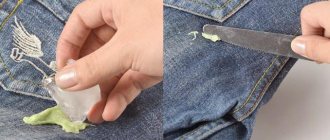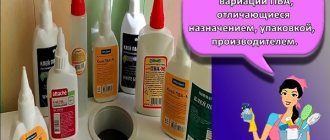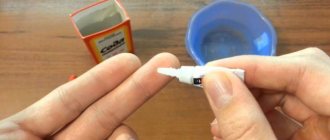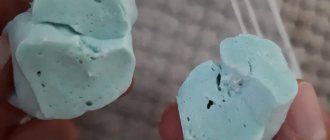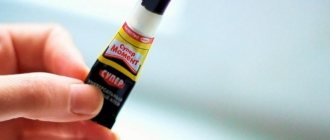How can you dissolve cyanoacrylate?
The only composition that dissolves very slowly in water is methyl cyanoacrylate. But superglue based on ethyl cyanoacrylate should not be wiped off with water, gasoline, or alcohol - it instantly hardens under their influence. If it has not yet dried, you can try acetone and acetonitrile.
Interesting materials:
What natural magnets exist in nature? What factors influence the magnitude of the thermal effect of a reaction? What factors influence the yield of raw gluten? What surnames did only nobles have? What kind of figures does Timati collect? What films were filmed in Polyarny? What films did Luc Besson create? What formats does the DVD player read? What formats does Windows Media Player support? What fruits does the elephant like?
How to restore a glue stick
PVA normally contains water, so it should be restored with water. Try giving the glue a water bath. This term means that the pencil in the open state must be held over a small volume of steam for about five minutes, that is, the glue of the pencil must be melted. Another way: you can put an open glue stick in a bag along with a wet napkin and sponge and put it in a warm place. In other words, PVA glue must be soaked in water and then melted.
If your PVP, which contains glycerin as a humectant, has dried out, you can restore the pencil only with glycerin. The method for resuscitating it is similar to the same process with PVA. Try moistening a cosmetic cotton pad with glycerin and wrapping it around a glue stick, putting it in a bag, and the bag itself on a hot radiator.
If you came up with the idea of trying to melt PVA or PVP in the microwave, then you should not do it. All you will achieve by doing this is the final evaporation of the remaining liquid from the mass, then you will have even more difficulty in recovery.
Review of popular brands
There are many glue sticks on sale from different manufacturers. It is quite difficult to answer the question which one is better. But it’s worth getting to know the main suppliers of adhesive sticks to the consumer market.
Erich Krause Joy
Erich Krause is an international company. It produces stationery, art supplies, school bags and backpacks, gifts and decorative items. Products are sold through the company's sales network and distributors. Consumers consider Erich Krause Joy glue sticks to be among the best on the market. The peculiarity is that the adhesive composition is tinted. The color disappears after joining the parts. This helps to cover the entire work surface with glue without leaving any dry areas. Children are amused by chameleon glue.
Erich Krause Joy is a PVP adhesive that allows you to glue paper, cardboard, and textiles. It is convenient to work with it in the office and do creative work at home.
Erich Krause Crystal
Erich Krause Crystal is another product from Erich Krause. This is a clear glue stick. The adhesive is designed for gluing paper, thin cardboard and photographs. It is elastic. Applies evenly and leaves no residue. Equally well suited for office work and activities with children. Users noted only one drawback - the relatively high price. But not a single one regretted the purchase.
Kores
Kores is a fairly well-known manufacturing company in Australia. The family business produces office products and school supplies. Kores glue stick is PVP glue. Glycerin, which is part of it, ensures soft gliding. The pencil does not dry out for a long time. Its traces are washed off well with water. The glue is colorless. The sealed packaging reliably protects the pencil from drying out. Kores glue stick glues paper, textiles, photo paper, and cardboard.
Comus
Komus is Russian. This trading and manufacturing company has been operating in the country since 1990. The enterprise was founded on the basis of a student cooperative. Komus produces and sells:
- stationery;
- paper;
- cardboard;
- packaging;
- office equipment;
- Consumables;
- furniture for offices.
Comus glue stick is filled with PVP glue. Its purpose is to glue paper, cardboard, fabric and photographs. The glue is transparent. There is no adhesive pigment in it. Consumers note good value for money, high glue efficiency and excellent elasticity.
See also
Types and brands of adhesives for gold leaf, DIY recipes
How to soften slime if it has become hard (if the slime has dried out)
Do you want to know how to soften slime? Here you go. Due to improper storage, the toy may shrink in size, stretch poorly and tear. No need to throw it away right away, let's try to save your friend. For these purposes, water, glue, shaving foam or boric acid are used. But you need to soften the slime with exactly the same products that were originally in its composition. In this case, it will regain its previous consistency.
We influence with heat
Change of structure
Let's figure out how to make the slime softer again. Let's look at some of the best instructions to help your slime soften if it's not stretching. They are based on exposure to high temperatures, as a result of which the structure of the toy becomes softer. Make sure children do not get burned when using these methods.
Using boiling water
Pour 150 ml of boiling water into a small bowl and place the affected toy in the container. Cover with a lid and leave for 5-10 minutes. After the specified time, carefully remove the lump and begin kneading without waiting for it to cool completely. The recipe is suitable if you need to soften slightly dried slime.
Soften in the microwave
If you need to quickly soften store-bought or homemade slime, this simple method will do. Place the toy in a plastic bowl, add 5 ml of boiling water and microwave for 40 seconds. The lump will become soft again and will stretch.
Let's introduce boric acid
If a lot of liquid is added to it when making a stretchy toy, the mass will harden and begin to release water. Let's figure out how to make it stretch again and become like new. You will need:
- Colgate toothpaste without whitening properties;
- boiling water;
- boric acid.
Pour 50 ml of boiling water into a deep bowl, add 0.5 teaspoons of Colgate and stir until a bubbly surface forms. Add the slime to the resulting mixture and stir with a spoon for about 5-7 minutes. As it absorbs more water and toothpaste, you will see results. The mass will stick to the walls, but after 5 minutes of constant stirring it will begin to curl into a lump. Add 15 ml of boric acid and continue stirring. If the slime does not curl, you need to add another 10 ml of thickener.
Save with shower gel
Now we’ll step by step figure out how to make the slime softer if it was initially stretchy and then hardened. You will need 100 ml of boiling water, 10 ml of thick shower gel or any shampoo. Add the ingredients to the bowl and mix everything thoroughly. Dip the slime into this mixture and knead with your hands until it becomes soft. The lump will increase in size and become fluffier. This is the first stage of softening.
Now place the dried slime in a clean container to dry it of excess liquid. You can blot it with a napkin. After this procedure, the slime often begins to stick to your hands, so you need to add 1 teaspoon of boric acid. If you did everything correctly, the lump will become soft and stop sticking to the skin.
If you overdo it and the consistency has become too thin, mix 5 g of soda in 100 ml of water and add 15 ml of the resulting mixture to the slime. Read more in the article “What to do if the slime is too liquid and does not thicken.”
No heat instructions
What to do if the slime is dry
If a stretchy lump has never dried out before, but now stretches heavily in your hands, let’s try to save it with the help of cosmetics. Be careful with them. If you overdo it, the slime will become too runny.
Dilute with Johnson's Baby Lotion
The slime should be soft so that it can be stretched comfortably. If it becomes hard and begins to tear, try diluting it with Johnson's Baby body lotion. Pour 10 ml of product onto the toy and knead like dough. After a couple of minutes, you will feel that the slime becomes more pliable and stretches well again.
Add body cream
There is another instruction on how to make the slime that dries softer . It is not suitable for rehabilitating store-bought slime, only for homemade slime. Squeeze 20 ml of body cream into a bowl. Use a thinner product; a thick buttercream is not suitable.
Now add 5 ml of water, stir the mixture, dip the slime in it and leave for 4-5 minutes. To make it softer, knead it thoroughly in hands lubricated with cream.
Using varnish remover
The new slime is pliable and stretches well in your hands. If it has dried out and is torn, let's try to make it more viscous again. You need to pour 0.5 teaspoon of nail polish remover onto the lump. It will feel pleasant and knead it will be very easy. Now you need to add shaving foam (3-4 sprays) and knead again in your hands. The slime will stretch again and become elastic.
Do not allow nail polish remover to come into contact with mucous membranes and do not inhale its vapors.
Saving with shaving foam
If the slime you made at home doesn’t stretch and breaks, we’ll try to save it with shaving foam. Don't use the gel because it has a completely different consistency and is useless when softening. Make 3-4 sprays per lump and knead in your hands. The toy will increase in size and become more magnificent. If it sticks to your hands too much, add 1 teaspoon of boric acid and knead again. For convenience, you can do this in a thick plastic bag.
Toothpaste and Panthenol
There is another instruction that tells you what to do if the slime is dry and breaks when stretched. Squeeze 0.5 teaspoon of toothpaste onto it and gently knead. Take a product without large granules and bleaching properties so as not to harm the skin of your hands.
Knead the toy vigorously, and after a couple of minutes it will become softer. But this is not the end of the instructions. To extend the life of a funny lump, take Panthenol in the form of a spray, make 2 sprays and continue to knead the lump. At first it will resemble rubber, but after 10 minutes it will slightly change color and become viscous.
If you liked the article, please like and share the link on social networks.
In the comments, tell us if you had to use the above instructions.
lizuny.ru
How to unscrew a dried tube of glue
If the tube cap is completely dry, there are several good methods that will allow you to solve this problem at home.
- Clamp the tube itself in the pliers and twist the cap by hand.
- Clamp the tube in the joint and twist the cap in the same way.
- Heat the lid in boiling water; it will expand and make it easier to unscrew.
- Just pierce the top of the tube with an awl, but use this method only in extreme cases, since you will then have to throw away the glue, and you can stain the surrounding area and yourself.
Experience - resuscitation of materials (soften clay and glue)
Greetings to the community!
I want to share my experience in restoring materials, perhaps it will be useful to someone. I’m a big hamster myself and I’m very sorry to throw away spoiled materials, I sculpt with long breaks, so I often wonder about “reanimation”. Dried self-hardening clay such as cold porcelain (tested on Modern clay, Modena clay in a blue pack) is perfectly softened by cosmetic cream (I have regular Nivea). The only condition is that the clay should be no tougher than the consistency of unchewed Wrigley-type chewing gum (if a dried crust appears, it must be removed - I was unable to soften it even after prolonged exposure). It is worth paying attention that the cream should preferably be white, because... a slight tint may appear (for example, unpainted Modern clay acquires a dirty tint when trying to restore it with light green and pink creams). But if you paint the clay with a well-opaque paint, the light colored cream will be invisible. You can also successfully soften colored clay, and it will lighten slightly—literally by half a tone—and become more whitish. In this case, you will need more cream and the effect will last shorter than for unpainted clay; you'll have to work a little faster. Dried marshmallows (tested on Hearty soft) soften with a bang with water. I just periodically dip my fingers in water and knead the clay with them. It was not possible to restore it with cream - the clay came in pieces and nothing more could be done with it (except throwing it away).
Well, the last observation is working with latex glue. I don’t like PVA’s properties, and latex glue has the unfortunate property of thickening very quickly. To prevent thickening, I pour it into very small jars that can be tightly closed. But if the glue has thickened, it can be diluted with a small amount of ordinary water, constantly and thoroughly stirring with a stick when pouring (latex glue does not lose its adhesive properties - tested). At first there will be lumps, which will dissolve with time of stirring. The exception is completely dried latex glue; I couldn’t dissolve it (or I didn’t have the patience
